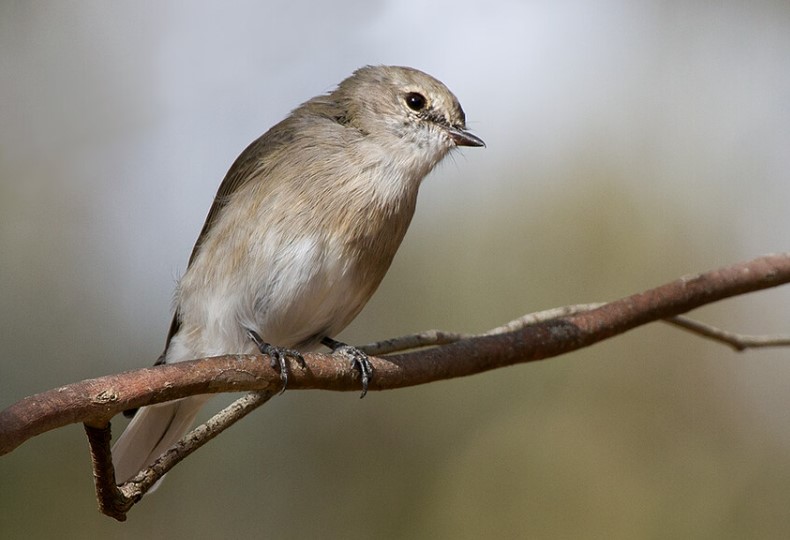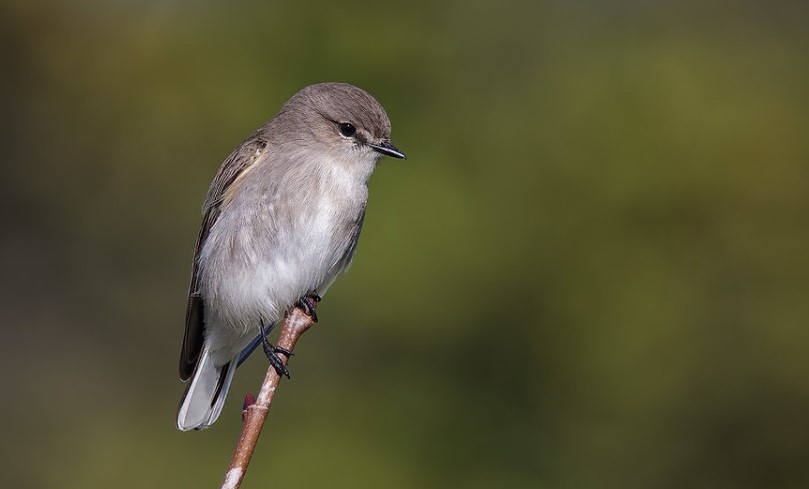Throughout the open eucalypt woodlands of Australia, Jacky Winter (Microeca fascinans) is widely distributed. The Jacky winter is a bird that is familiar to most rural areas of the country. There are many similarities between this species and the Lemon-bellied Flycatcher in terms of feeding niche and habitat, but in the north of the country, it prefers more open, drier woodland where the birds overlap.
It is preferable to hawk along forest edges or along lines of woodland through open fields, as long as the undergrowth is clear enough to allow the birds to fly freely, and bare branches and stumps are found at one to five meters above the ground. As is the case with most flycatcher species, Jacky Winters feed by sallying out from set perches like branches, stumps, posts, and wires where there is a bare, exposed surface.
A variety of insects are picked out by them as they flutter in leisurely sorties, flying through the air, picking up insects from foliage, and even picking up insects from tree trunks and the ground as they return to their perches. During feeding flights, the birds are able to cover a large area; on these flights, they can catch a large variety of invertebrates, such as grasshoppers, crickets, termites, bugs, weevils, gnats, butterflies, ants, bees, spiders, and adult and larval beetles, flies, and moths.
Read More – Lemon-bellied Flycatcher – A Pinnacle of Avian Elegance
When the birds are feeding, they do so most often in the morning and at dusk, but sometimes they will join mixed flocks of other species when they feed. There is a gentle and graceful way in which these birds feed, and their aerial maneuverability at slow speeds is enhanced by the shape of their wings and tails.
It is likely that the birds hover a lot when they are looking for food, either low over the ground or near tree trunks and foliage. They dive, twist and turn easily when searching for food. As they sit quietly on their perches, they may often twitch their tails from side to side, and show their white shafts in an effort to keep in touch with one another; this signaling may serve as a means to maintain contact between the individuals.
A Jacky winter is a fairly sedentary species, often confined to the same area of 10-15 hectares of land all year round; birds in marginal regions and young birds of the year may disperse wider during the winter when the southernmost populations often shift a little northward. Unless a family group forms at the end of the breeding season, most birds are solitary or live in pairs. The Jack Winter is a relatively silent bird for the majority of the year, but when breeding, they sing continuously throughout the day, either in circling song-flight around treetops or more often from a perch that provides a vantage point.
The song can also be heard in the dawn chorus at other times of the year. It takes both sexes about eight days to build the nest-a tiny cup-and all of these tasks are shared between the sexes, including incubation, brooding, and feeding the young. The sitting birds are fed by their mates at the nest when they are sitting. This bird is also known as the Brown Flycatcher, Peter-Peter, Postsitter, Stump-bird, and Spinks. As far as the size of Jacky winter is concerned, it is approximately 120-140 mm in length.
There is no difference between the sexes when it comes to adults. The upper parts of the body are gray-brown to light grey-brown; the brow over the lores and the eyes are white. A brown wing with white edging on its inner flight feathers, a blackish tail with white edging, and tips on the outer two or three pairs of feathers.
The underparts are white, while the breast is washed a pale grey-brown color. Brown is the color of the eyes. The bill and the feet of this bird are dusky in color. As they mature, they resemble adults, with small white tips on the primary wing coverts. The juvenile has brown upper parts with cream spots and arrow-shaped markings; brown spots, concentrated over the breast, are on the underparts of the bird.
The call of Jacky Winter is generally characterized by high whistling notes, which may be heard from both sexes. In spring and summer, Jacky Winter’s song is sweeter, more musical, and varied than in winter and spring, but is a jingling, far-carrying, paired double syllable, peter-peter, repeated quickly several times, by both sexes.
A nesting and breeding season usually occurs between July and August and January and February. In the north, nesting and breeding seasons can be affected by rainfall. A tiny nest was made by Jacky Winter in the form of a fragile saucer made of fine grasses, rootlets, sometimes hair, sometimes fine bark, bound with cobweb, decorated with lichen or bark, lined with finer fiber, sometimes fur or feathers, and placed on a large, bare branch or horizontal fork, which was typically between 0.5 and 22 m above the ground.
The bird usually lays two eggs, rarely three; they are pale grey or green-blue in color and they are marked all over with browns and lavender grays, often forming a cap or band at their larger end. The eggs are long and oval in shape and measure about 20 x 15 mm in size. As far as the incubation period goes, it is about 17-18 days for both sexes. It takes about 18 days for the young to fledge.
When it comes to Jacky Winter’s distribution, Jacky Winter can be found in dry eucalypt forests, woodlands, mallee areas, cultivated lands, and grazing pastures throughout Australia. There is a fair amount of this species in the east and south, but it is less common in the north; the species is absent from the Northern Cape York Peninsula and the higher Australian alps. New Guinea is also home to this species in the southeastern part of the country.
There are three races, and two are found in Australia: one, grey-brown-backed, with two outer pairs of tail feathers entirely white, inhabits woodlands throughout the east and north of Australia, including Mt Lofty Ranges; and the other, a dark brown-backed bird with only the outermost pair of tail feathers almost all white, which inhabits southwest and central Australia until the Murray Mallee in the north.
It is possible that these two races represent different species, but there is no clear evidence that this is the case intermediaries have been discovered from areas of contact. Northward, the eastern race’s populations tend to become paler and smaller as they move northward.
Read More – Yellow-throated Miner (Manorina flavigula)




